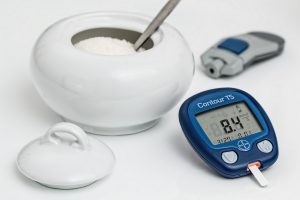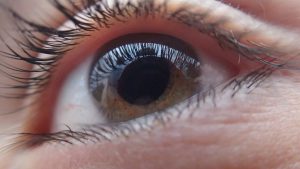The number of people with diabetes has risen from 108 million to 422 million in only 35 years, and the rate of increase is getting worse. Diabetes affects the body’s ability to produce or use insulin to control blood sugar levels. If blood sugar levels are high for a long time, it can damage essential organs, including the eyes. Diabetic retinopathy can cause blindness, and lead to other blinding eye diseases. So, if you have

diabetes, prevention is key.
Diabetic Retinopathy
Diabetic retinopathy is an eye disease that causes vision loss and blindness in people with diabetes. It is the leading cause of blindness in American adults. Blood vessels in the retina, the light-sensitive layer of tissue at the back of the eye, will swell, leak, or close off. Abnormal blood vessels can grow on the retina’s surface as well. Early stages of this disease do not usually have symptoms.
During the later stages of diabetic retinopathy, blood vessels in the retina will bleed and leak into the vitreous. A sure sign this has happened is when a person sees dark, floating spots or streaks. If you do not treat it in time, the bleeding will continue, worsening the condition, and cause scarring. Diabetic retinopathy can lead to other serious eye diseases such as:
Diabetic Macular Edema- Over time, half of people with diabetic retinopathy will develop diabetic macular edema. This is when small blood vessels in the center of the retina, called the macula, leak and cause swelling in the retina. It will cause a person’s vision to become blurry, and can lead to permanent vision loss.
Cataracts- Diabetes makes you 2-5 times more likely to develop cataracts because of the high blood sugar levels. A cataract is when the eye’s lens clouds, causing blurriness. Luckily, it can be treated with surgery.
Glaucoma- Diabetic retinopathy causes abnormal blood vessels to grow out of the retina and block fluid. The fluid is not able to drain from the eye, causing glaucoma. The optic nerve is damaged and leads to irreversible vision loss.
Symptoms

To reiterate, the symptoms of diabetic retinopathy can include:
- Blurry vision
- Flashing lights
- Cloudiness
- Dark or floating spots
- Blind or blank spots
Risk Factors
If a person has diabetes, they are at risk for developing diabetic retinopathy. This includes people with type 1, type 2, and gestational diabetes. The longer that a person has diabetes, the more likely they are to develop diabetic retinopathy. About 2 in 5 Americans with diabetes have some form of diabetic eye disease. High sugar levels affect your eyes greatly.
There are usually no warning signs for diabetic eye diseases, but if you go for regular eye exams, it can be caught early. Make sure to schedule yearly eye exams, and if you have moderate to severe retinopathy, then an exam should be scheduled every 6-12 months. In order to lower your risk of diabetic eye diseases, it is important to manage your diabetes. Having high blood pressure and high cholesterol increases your risk. Keep blood sugar levels as normal as possible, eat healthy, and exercise every day, this will help you control diabetes, blood pressure, and cholesterol levels.